RAÍCES
DIGITAL
ARCHIVE
Preserving cultural roots, sharing undertold stories.

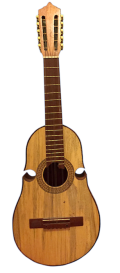
Full Oral History Interview: Raíces Digital Archive
José Gabriel Muñoz was born in Puerto Rico in 1976. When he was 2, his family moved to New Jersey, where he grew up and still resides. He was introduced to the cuatro— the national instrument of Puerto Rican —at the age of 14. Gabriel fell in love with the instrument’s sound, and asked his father to purchase one for his upcoming birthday. So on his 15th birthday, he received his first cuatro as a gift, which he says changed his life forever.
Gabriel Muñoz & Melodías Borinqueñas
Performance at the Forum Theatre in Metuchen, New Jersey – 2018
The song is entitled “Ni la alquilo ni la vendo” played in the style known as Seis Bayamones.
Video: Raíces Digital Archive
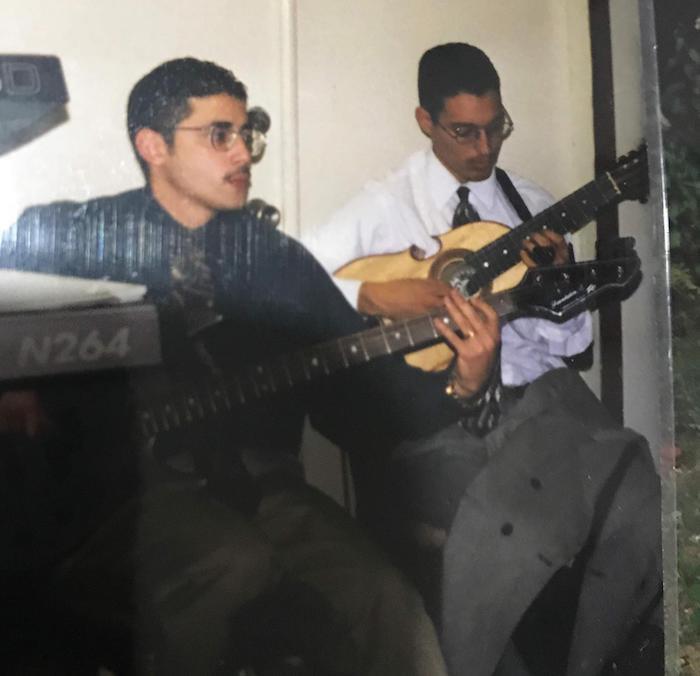
Photo: Raíces Digital Archive
Gabriel’s beginning years as a cuatrista. Here he is with bass player Lemuel Bonetta.
Full Oral History Interview: Raíces Digital Archive
Full Oral History Interview:
Raíces Digital Archive
Gabriel Muñoz was born in Utuado, Puerto Rico in 1976. When he was 2, his family moved to New Jersey, where he grew up and still resides. He was introduced to the cuatro—a traditional Puerto Rican musical instrument similar to the mandolin—at the age of 14. Gabriel fell in love with the instrument’s sound, and asked his father to purchase one for his upcoming birthday. So on his 15th birthday, he received his first cuatro as a gift, which he says changed his life forever. He then began honing his skills on the instrument through constant practice and immersing himself in the cuatro and in Puerto Rican music.
Gabriel Muñoz began studying cuatro with Alvin Medina at age 14 after seeing him play and becoming captivated by the instrument. Alvin Medina is a world renowned interpreter of the cuatro. Here he is with Gabriel accompanying him on the guitar in 2012.
You can visit Alvin’s website here: www.alvinmedinamusic.com
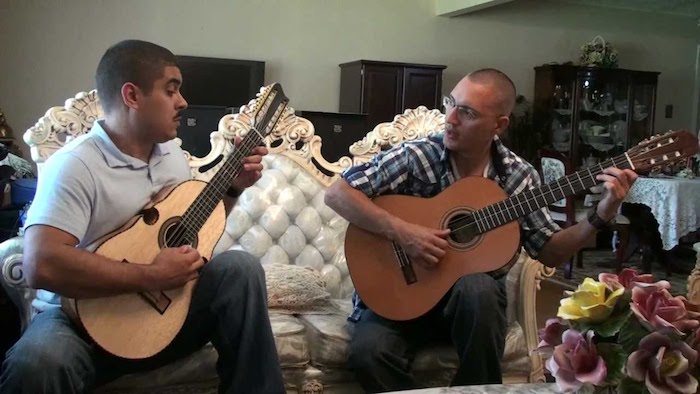
Photo Courtesy José Gabriel Muñoz
Full Oral History Interview: Raíces Digital Archive
Gabriel’s first cuatro, given to him as a 15th birthday present from his father who purchased it for $50 on the street.
Full Oral History Interview: Raíces Digital Archive
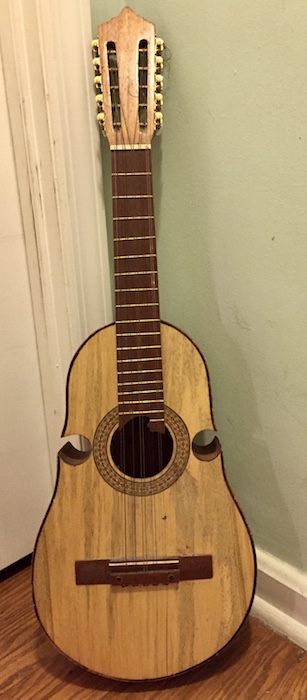
Photo: Raíces Digital Archive
Full Oral History Interview: Raíces Digital Archive
Video Courtesy José Gabriel Muñoz
Here is Gabriel playing J.S. Bach’s Cello Suite in G on the cuatro at his Library of Congress performance.
View 39 items tagged “José Gabriel Muñoz” on the Raíces Digital Archive
One of Puerto Rico’s most popular acoustic instruments is the cuatro, its shape resembles that of a violin. Originally this instrument had four double-strings. As its popularity grew by the beginning of the 20th century, a fifth set of strings were added. Guaraguao wood is the standard in the construction of the body and the top is made of yagrumo wood. However, this instrument is now made in a variety of wood. The cuatro to the right is made by luthier William Cumpiano. You can visit his site here: www.cumpiano.com/latin-american-guitars.

Full Oral History Interview: Raíces Digital Archive
:format(jpeg):mode_rgb():quality(90)/discogs-images/A-403433-1490208952-8084.jpeg.jpg) Photo embedded from Discogs.com
Photo embedded from Discogs.com Jíbaro is a term used to refer to mountain people, who lived “in-land” in the heart of the island, and are the backbone of the Puerto Rican culture. To read more of this excerpt please visit: www.elboricua.com/jibaro.html
Nieves Quintero “My name is Manuel Quintero Maldonado, but I’m known as Nieves Quintero, which are my father’s two last names. I gave the cuatro a new flavor. And I always told myself that I was going to play the cuatro differently from the way Ladi and my cousin Archilla, played it. That’s what was on my mind…yes, it’s true, I thought, I’m going to create a style with a new sound.” This is an excerpt from the Puerto Rican Cuatro Project. The article isn’t complete yet, but take a look at the site here.
Full Oral History Interview: Raíces Digital Archive
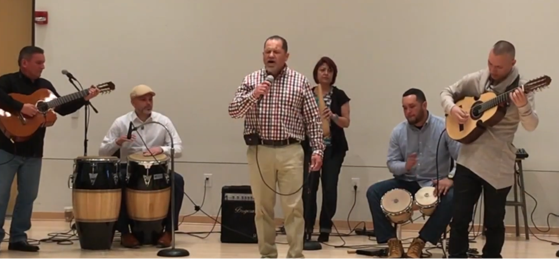
Photo: Raíces Digital Archive
This is Gabriel’s ensemble Melodías Borinqueñas. With the exception of the congas added to the group, this is what a jíbaro conjunto looks like.
Ladislao Martínez, mentioned in this clip, was a master interpreter of the cuatro who revolutionized the instrument in the early part of the 20th century. You can read his story on the Puerto Rican Cuatro Project website.
:format(jpeg):mode_rgb():quality(90)/discogs-images/A-5496642-1484276559-5763.jpeg.jpg)
Photo embedded from Discogs.com
Full Oral History Interview: Raíces Digital Archive
Like many folkloric instruments from different parts of the world, cuatro is not an instrument commonly played by musicians in New Jersey. Gabriel found that to be one of the few challenges of being a cuatrista growing up in New Jersey and living off of the island of Puerto Rico.
One notable exception to the general lack of cuatristas in New Jersey was Don Tuto Feliciano, a musician from Perth Amboy, NJ who played the cuatro, the Cuban tres, the requinto and the guitar.
Full Oral History Interview: Raíces Digital Archive
Full Oral History Interview: Raíces Digital Archive
Tuto Feliciano and the legendary jíbaro troubadour, Ramito playing together in the mid 1950s on stage at WKAQ-TV in San Juan, Puerto Rico. You can read more about Tuto here: http://www.cuatro-pr.org/node/175
Puerto Rican troubadour Ramito began his career after participating in a local troubadour’s contest in 1932, La Hora del Volante, reaching the climax of his career while participating in New York’s WHOM show La Montaña Canta. Flor Morales Ramos was also known as “El Cantor de la Montaña.”

Video Source: THE PUERTO RICAN CUATRO PROJECT YouTube Channel
For a sense of what the cuatro community is all about, please visit the Puerto Rican Cuatro Project’s website at: http://www.cuatro-pr.org/. Co-founders Juan Sotomayor, William Cumpiano and their crew have gathered an incredible repository of information on the subject of the cuatro.
In the course of beginning our collection of Roots Music Oral Histories, we set out to begin asking questions and analyzing social implications of modern practices of roots music traditions, including the impact of place, gender, and race. These can be tough questions, but they are important as roots music traditions continue to evolve in generations to come.
Full Oral History Interview:
Raíces Digital Archive
First female interpreter of the cuatro to graduate from the Berklee School of Music in Boston with a degree in the Puertorican Cuatro. See her here with her group Fabiola Méndez Trio s- Mind and Body.
Haciendo Punto en Otro Son – Innovative group that gave a new flavor, not only to the genre of music known as “Nueva Trova,” but broke with many of the barriers revolving around Puerto Rico’s gender, race and literary interpretation biases in song, story and poetry. Much of their music was centered around the cuatro. You can read more about the group here.
:format(jpeg):mode_rgb():quality(90)/discogs-images/R-5029914-1382579492-8924.jpeg.jpg)
Full Oral History Interview: Raíces Digital Archive
Eligio Claudio – Better known as “Prodigio” an international ambassador of the cuatro. A musical prodigy for the spread of the cuatro into the future. You can hear an interview with Prodigio here.
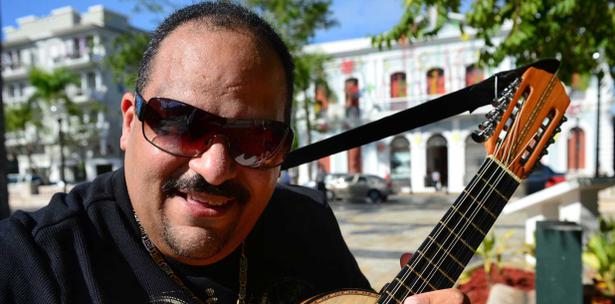
Photo embedded from primerahora.co
Full Oral History Interview: Raíces Digital Archive
Full Oral History Interview: Raíces Digital Archive
The traditional jíbaro music of Puerto Rico is timeless, though like all music and art, it continues to evolve. Gabriel is one of the many musicians on and off the island that are contributing to both the preservation and sharing of the traditional music and the evolution of the instrument and its musical applications to reach a younger generation as well as new and universal audiences.